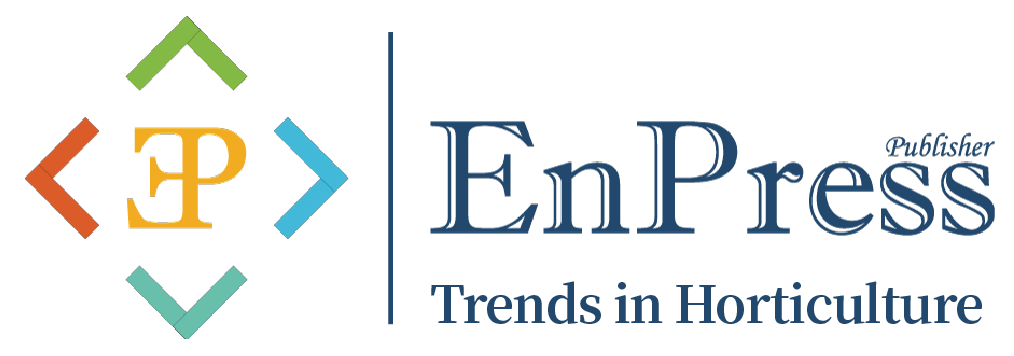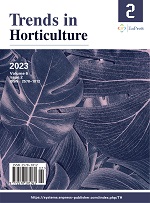(Online) Journal Abbreviation: Trends Hortic. | Trends in Horticulture (TH) is an international peer-reviewed, open access journal that focuses on publishing comprehensive and up-to-date information in the field of horticulture. The journal publishes papers on different topics related to horticultural sciences and technologies including vegetable crops, fruit crops, ornamentals, medicinal crops, edible fungus, urban horticulture, industries of horticultural crops, crop research in protected facilities or controlled environments, and plant research cultivated finely related to horticultural technology. The subject covers interdisciplinary research ranging from microbiology to horticultural crops, from gene screening to plant hybridization, from molecular biology to plant physiology and ecology, and from traditional planting to intelligent control. The Journal welcomes the original empirical and theoretical research articles, from the basic to the applied, and accepts high quality submissions presented as Original Research Articles, Review Articles, Brief Commentaries, Case Reports, and Letters to the Editor, in all areas of horticultural research. Through a meticulous process of peer review, TH strives to publish articles of the highest value for agricultural and horticultural professionals. |
Online Submissions
Registration and login are required to submit items online and to check the status of current submissions.
Already have a Username/Password for Trends in Horticulture?
GO TO LOGIN
Need a Username/Password?
GO TO REGISTRATION
Submission Preparation Checklist
As part of the submission process, authors are required to check off their submission's compliance with all of the following items, and submissions may be returned to authors that do not adhere to these guidelines.
- The submission has not been previously published, nor is it under the consideration of another journal (or an explanation has been provided in Comments to the Editor).
- The submission file is in Microsoft Word format.
- Where available, URLs for the references have been provided.
- The text adheres to the stylistic and bibliographic requirements outlined in the Author Guidelines, which is found in About the Journal.
- If submitting to a peer-reviewed section of the journal, the instructions in Ensuring a Blind Review have been followed.
Privacy Statement
The names and email addresses entered in this journal site will be used exclusively for the stated purposes of this journal and will not be made available for any other purpose or to any other party.
Article Processing Charges (APCs)
Trends in Horticulture is an Open Access Journal under EnPress Publisher. All articles published in Trends in Horticulture are accessible electronically from the journal website without commencing any kind of payment. In order to ensure contents are freely available and maintain publishing quality, Article Process Charges (APCs) are applicable to all authors who wish to submit their articles to the journal to cover the cost incurred in processing the manuscripts. Such cost will cover the peer-review, copyediting, typesetting, publishing, content depositing and archiving processes. Those charges are applicable only to authors who have their manuscript successfully accepted after peer-review.
| Journal Title | APCs |
|---|---|
| Trends in Horticulture | $500 |
We encourage authors to publish their papers with us and don’t wish the cost of article processing charges to be a barrier especially to authors from the low and lower middle income countries/regions. A range of discounts or waivers are offered to authors who are unable to pay the article processing charges. Authors can write in to apply for a waiver and requests will be considered on a case-by-case basis.
APC Payment
Payments for APC of this journal can be made through our online PayPal payment gateway. Enter the Article No. into the below textbox and select "Pay Now" to proceed with payment.
*Article No. is mandatory for payment and it can be found on the acceptance letter issued by the Editorial Office. Payment without indicating Article No. will result in processing problem and delay in article processing. Please note that payments will be processed in USD. You can make payment through Masters, Visa or UnionPay card.
Vol 8, No 1 (2025)
Table of Contents
Phytochemical and antioxidant analysis of some varieties of Capsicum was evaluated. Mature Capsicum varieties were collected across the State. The seeds were removed, sun-dried for 3 days, stored for 2 weeks at 15 ºC–25 ºC in polythene bags before planting. Saponins, tannins, flavonoids, alkaloids and cardiac glycosides were present in abundant, moderate and trace amounts. Combined anthraquinones were absent in all varieties. Yellow (0.810 ± 0.0006 µg/mL), red long dry (0.211 ± 0.0006 µg/mL) and round peppers (2.527 ± 0.0003 µg/mL) had the largest values for total phenol, flavonoids and tannins. Shombo and yellow peppers had the largest (0.270 ± 0.002 µg/mL) and least (0.102 ± 0.001 µg/mL) capsaicin content. The antioxidant activities varied across the varieties. At 100 µg/mL of methanol, yellow (45%) and round peppers (45%) had largest mean absorbances for 2,2-Diphenyl-1-Picrylhydrazyl (DPPH) Radical Scavenging Activity while sub-shombo pepper (23%) had the least. For Ferric Reducing Antioxidant Power (FRAP), yellow (0.63 ± 0.001 µg/mL) and sub-shombo peppers (0.55 ± 0.001µg/mL) had the largest and least values at 100 µg/mL of methanol. At 100 µg/mL of methanol, red long dry (0.112 ± 0.001) and shombo peppers (0.101 ± 0.001) had the largest and least values for the nitric oxide scavenging activity. This study shows that Capsicum varieties exhibit bioactive componds similarities and variations with implications in hybridization, taxonomy and conservation.
Tomato (Solanum lycopersicon L.) is a highly valued crop in the world, particularly in Nigeria with high nutritional and economic benefits. However, its production in Iwollo, Southeast Nigeria, is constrained by unfavorable weather conditions. To address this, a study was conducted at the Teaching and Research Farm, Department of Horticultural Technology, Enugu State Polytechnic, Iwollo, Southeast Nigeria to evaluate and select the best cultivar for high tunnel production using the Rank Summation Index. Completely Randomized Design with three replications was used, and six high-yielding cultivars, namely Roma VF, BHN-1021, Supremo, Pomodro, Money maker, and Iwollo local, were evaluated. Data were collected on key agronomic characters and analyzed with Analysis of Variance (ANOVA) at a 0.05 level of probability. There were significant differences in the number of leaves per plant, plant height, number of branches per plant, days to fruit maturity, fresh fruit weight, number of harvested fresh fruits per plant, and fresh fruit yield per plant among the cultivars. These characters that showed significant differences were ranked and summed up to obtain the Rank Summation Index (RSI) score. The results revealed that the Supremo cultivar had the lowest and best score (18). This suggests Supremo as the best cultivar for high tunnel tomato production in the study area, based on its superior performance across key agronomic traits.
Molybdenum (Mo) is considered and described as an essential element for living organisms’ development. Until now, no studies have been performed on genes involved in the Mo transporter in ancestral Ipomoea species. This study aimed to identify potential Mo genes in Ipomoea trifida and I. triloba genomes using bioinformatics tools. We identified four Mo transporter genes, two in I. trifida and two in I. triloba. Based on the RNA-seq datasets, we observed that Mo genes are expressed (in silico) and present different mechanisms between the tissues analyzed. The information generated in this study fills missing gaps in the literature on the Mo gene in an important agronomic crop.
Announcements
Vol 7, No.1 (2024) is released! |
|
The articles in this issue cover various aspects of horticultural crop research, including environmental drug residues, plant diversity, asexual reproduction, genetic analyses, plant resistance, and extended shelf life. Each study addresses practical problems and offers valuable insights and guidance for horticultural crop research. Please read here for research details. |
|
| Posted: 2024-07-06 | |
11th International Horticulture Research Conference! |
|
 |
|
| Posted: 2024-06-04 | More... |
New Style for TH Published Papers |
|
We have revised the layout for articles to be published in the new issues, starting at the beginning of 2024. As of today, the article template available for download on ‘Author Guidelines’ pages has been updated. The most noticeable change can be found on the first page of the article, where a left-hand column has been created to include the following front matter elements: (i) the recommended citation style for the article; (ii) the publishing history; (iii) the Creative Commons Attribution license used. Other front matter key elements such as publisher logo, article type, article title, authors, abstract and keywords have also been revised sightly.
Another major update is that new articles will be published under the Creative Commons Attribution (CC BY) license (https://creativecommons.org/licenses/by/4.0/). |
|
| Posted: 2024-01-11 | |
| More Announcements... |




 Open Access
Open Access

